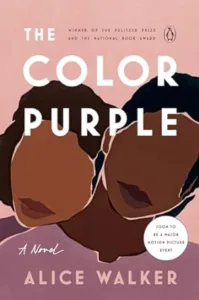The Color Purple
Alice Walker
Penguin Books
Published December 10, 2019 (Orig. 1982)
Amazon | Bookshop | Goodreads
About The Color Purple
Winner of the Pulitzer Prize and the National Book Award
A powerful cultural touchstone of modern American literature, The Color Purple depicts the lives of African American women in early twentieth-century rural Georgia. Separated as girls, sisters Celie and Nettie sustain their loyalty to and hope in each other across time, distance and silence. Through a series of letters spanning twenty years, first from Celie to God, then the sisters to each other despite the unknown, the novel draws readers into its rich and memorable portrayals of Celie, Nettie, Shug Avery and Sofia and their experience. The Color Purple broke the silence around domestic and sexual abuse, narrating the lives of women through their pain and struggle, companionship and growth, resilience and bravery. Deeply compassionate and beautifully imagined, Alice Walker’s epic carries readers on a spirit-affirming journey towards redemption and love.
“Reading The Color Purple was the first time I had seen Southern, Black women’s literature as world literature. In writing us into the world—bravely, unapologetically, and honestly—Alice Walker has given us a gift we will never be able to repay.” —Tayari Jones
“The Color Purple was what church should have been, what honest familial reckoning could have been, and it is still the only art object in the world by which all three generations of Black artists in my family judge American art.” —Kiese Laymon
My Review
This is my first time reading The Color Purple. I went back and forth between an ebook version and the audiobook version read by Alice Walker. She’s an excellent reader– I really enjoyed listening to her bring her characters and the story to life.
As you can see from the content section below, The Color Purple is a pretty heavy story about a woman who is abused by her father and then her husband before she falls in love with a woman. Through it all, the closest relationship, and the one she cherishes most, is the one between her and her sister, who has moved to Africa with a missionary couple.
It’s also an epistolary novel. At first, the book is the letters Celie writes to God. Later, it’s filled with the letters exchanged between Celie and her sister, Nettie. If you know me, you know I love sister stories, so this one has been on my reading list because of that.
I loved the relationship between Celie and Nettie. They may be far apart, and they may not know whether their sister has received any of their letters, but they continue writing and sharing their lives with one another.
Reading The Color Purple made me think a lot about women’s relationships because, at its heart, that’s really what this story is about. It’s about the power of friendship and love between women and what it can do. It teaches a lonely woman to love and be loved. It gets a woman out of prison. Love inspires a woman to open her own business. It connects women across seas, continents, and decades.
Conclusion
I really liked this book. Between the sister bond and the way that the women in the story developed relationships and cared for one another and one another’s families, I really invested in the story. I kept thinking about Celie and the other characters when I wasn’t reading. I can see why this book remains so popular and beloved. It’s got some heavy content, so this won’t be a story for everyone, but I think it’s beautifully written, and I’m so glad I read it this year.
Content Notes
Recommended for Ages 16 up.
Profanity/Crude Language Content
Some explicit language used infrequently to describe sex. Some racist words used.
Romance/Sexual Content
The opening scene briefly (but graphically) describes a girl’s father raping her. She states that those attacks continue, but doesn’t further describe them. Later, she references sex with her husband in detached language, showing it’s not something she enjoys.
Another woman talks to Celie about her body and encourages her to explore her body on her own, which she later does. Two women kiss and touch each other (briefly described) and fall asleep together.
Another character reports that someone assaulted her.
Spiritual Content
Celie’s sister, Nettie, joins a Christian missionary group. Shug reminds Celie that the bible says not to kill anyone, and that Jesus faced his own trials and challenges.
Celie and Shug discuss God’s identity and how they imagine God. Shug rejects the idea that God is white or a man and instead thinks of all of creation as part of God and God being in all of creation. They discuss how the Bible describes Jesus’ hair as being like lamb’s wool.
Nettie describes the Olinka people’s worship of roofleaf, a plant they use to cover the tops of their homes.
Violent Content
Three scenes show brief but graphic descriptions of sexual assault or attempted assault. Brief descriptions of domestic abuse.
Two women briefly fight. A white man slaps a Black woman. She punches him in the face. The next time Celie sees her, she describes the horrific bruises and swelling left after the police brutally beat her.
References to FGM. References to colonialism, the history of slavery, and the abuse of plantation workers.
Drug Content
Adults drink alcohol and smoke. References to smoking marijuana as a habit or as part of a spiritual experience.
Note: This post contains affiliate links, which do not cost you anything to use but help support this blog. All opinions are my own.

















